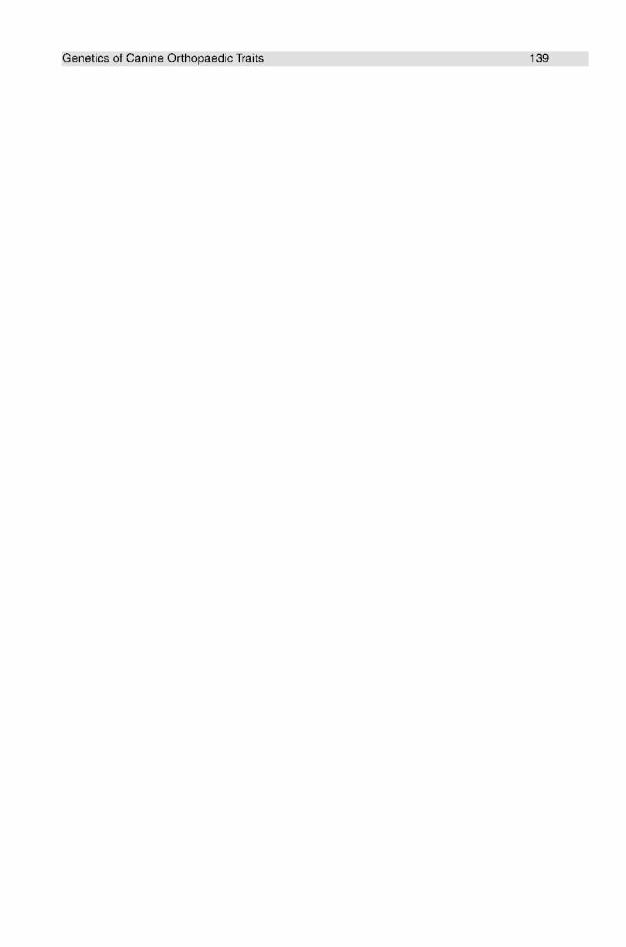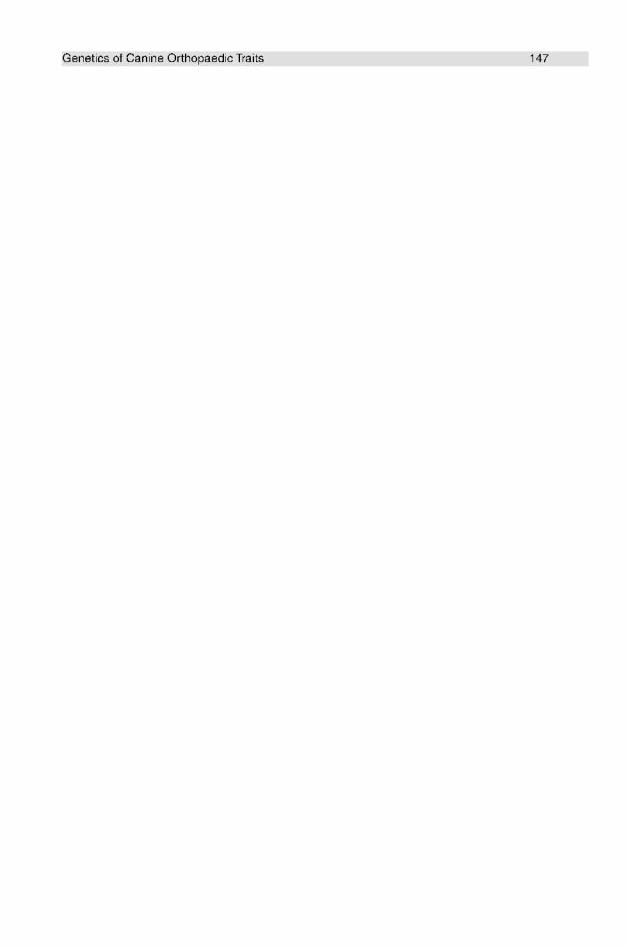
The genetics of dogs
.pdf


Table 7.2. Canine chondroand osteodysplasias. The conditions in bold are further discussed in the section on 'Molecular Genetics of Canine Disorders with Orthopaedic Manifestations' (after Breur et al., 2001, 2010).
Breed |
Trait |
Akita (Sande et al., 1994) |
Achondrogenesis |
Alaskan Malamute (Fletch et al., |
Chondrodysplasia |
1973, 1975; Bingel et al., 1980, |
|
1985) |
|
Beagle (Rasmussen, 1971, 1972; |
Chondrodysplasia punctata |
Sande and Bingel, 1983; Campbell |
Multiple epiphyseal dysplasia |
et al., 1997, 2001) |
|
|
Osteogenesis imperfecta |
Bulldog (Louw, 1983) |
Osteochondrodysplasia |
Bull Terrier (Watson et al., 1991) |
Osteochondrodysplasia |
Cocker Spaniel (Beachley and |
Hypochondroplasia |
Graham, 1973) |
|
Mode of |
Laboratory |
|
inheritance |
test |
Demonstrated biochemical and/or molecular defects |
Unknown |
No |
|
Autosomal |
No |
Type II collagen is abnormally soluble in neutral salt |
recessive |
|
solutions as it has significantly more proteoglycans |
|
|
with longer proteoglycan monomers and longer |
|
|
chondroitin sulfate side chains with increased |
|
|
amounts of chondroitin-6-sulfate |
Unknown |
No |
|
Autosomal |
No |
|
recessive |
|
|
Unknown |
No |
COL1A2 mutation |
Unknown |
No |
|
Unknown |
No |
|
Unknown |
No |
|
Collie (Holmes and Price, 1957) |
Osteogenesis imperfecta |
|
No |
|
Dachshund (Drogemtiller et al., |
Osteogenesis imperfecta |
Unknown |
No |
SERPINH1 mutation |
2009) |
|
|
|
|
Dunker (Rorvik et al., 2008) |
Multiple epiphyseal dysplasia |
Unknown |
No |
|
English Pointer (Whitbread et al., |
Enchondrodystrophy |
Homozygous |
No |
|
1983) |
|
recessive |
|
|
Golden Retriever (Campbell et al., |
Osteogenesis imperfecta |
Unknown |
No |
COL1A1 mutation |
2000) |
|
|
|
|
Great Pyrenees (Bingel and Sande, |
Chondrodysplasia |
Autosomal |
No |
|
1994) |
|
recessive |
|
|
Hygenhund (Rorvik et al., 2008) |
Multiple epiphyseal dysplasia |
Unknown |
No |
|
Irish Setter (Hanssen, 1992; Hanssen |
Hypochondroplasia |
Autosomal |
No |
|
et al., 1998) |
|
recessive |
|
|

Labrador Retriever (Carrig et al., |
Oculoskeletal dysplasia |
Autosomal |
No |
COL9A2 and COL9A3 mutations |
1977, 1988; Goldstein et aL, 2010) |
|
recessive |
|
|
Miniature Poodle (Cotchin and Dyce, |
Achondroplasia |
Autosomal |
No |
Primary defect in sulfation pathway or increased |
1956; Gardner, 1959; Amloff, 1961; |
|
recessive |
|
activity of sulfatase enzymes |
Lodge, 1966; Bingel et al., 1986) |
Multiple epiphyseal dysplasia |
Unknown |
No |
|
|
Pseudoachondroplasia |
Unknown |
No |
|
Mixed breed dog (Haskins et aL, |
Mucopolysaccharidosis VII |
Autosomal |
Yes |
13-o-glucuronidase deficiency |
1984) |
|
recessive |
|
|
Norwegian Elkhound (Bingel and |
Chondrodysplasia |
Autosomal |
No |
|
Sande, 1982) |
|
recessive |
|
|
Plott Hound (Shull et aL, 1982; |
Mucopolysaccharidosis I |
Autosomal |
Yes |
a-L-glucuronidase deficiency |
Spellacy et aL, 1983) |
|
recessive |
|
|
Samoyed (Meyers et al., 1983; Aroch |
Oculoskeletal dysplasia |
Autosomal |
No |
|
et al., 1996) |
without hematological |
recessive |
|
|
|
abnormalities |
|
|
|
|
Oculoskeletal dysplasia with |
Unknown |
No |
|
|
haematological |
|
|
|
|
abnormalities |
|
|
|
Scottish Terrier (Mather, 1956; Hay |
Achondroplasia |
Unknown |
No |
|
et al., 1999) |
Idiopathic multifocal |
Unknown |
No |
|
|
osteopathy |
|
|
|
Scottish Deerhound (Breur et al., |
Pseudoachondroplasia |
Autosomal |
No |
|
1989, 1992) |
|
recessive |
|
|
Shiba !nu (Suu, 1956, 1957, 1958; |
Short-spine syndrome |
Unknown |
No |
|
Ueshima, 1961; Hansen, 1968) |
|
|
|
|

Table 7.3. Paediatric bone and joint conditions with a proven or presumed genetic aetiology. The conditions in bold are further discussed in the section on
`Molecular Genetics of Canine Disorders with Orthopaedic Manifestations' (after La Fond et al., 2002; and Breur et al., 2010). |
|
||||
Trait |
Incidence |
Breeds at risk |
1.72 |
Sex |
Comments |
Paediatric bone conditions |
|
|
|
|
|
Craniomandibular |
1.4 per 100,000 |
Cairn Terrier, Scottish Terrier, West Highland White Terrier |
|
M = F |
Autosomal recessive in |
osteopathy |
|
|
|
|
West Highland White |
|
|
|
|
|
Terriers C, D |
Hypertrophic |
2.8 per 100,000 |
Boxer, Chesapeake Bay Retriever, German Shepherd Dog, Golden |
0.68 |
M > F |
B, C, D, E |
osteodystrophy |
|
Retriever, Great Dane, Irish Setter, Labrador Retriever, |
|
|
|
|
|
Weimaraner |
|
|
|
Panosteitis |
2.6 per 1000 |
Afghan Hound, Akita, American Cocker Spaniel, American |
0.13 |
M > F |
A, B, C, D, E, F |
|
|
Staffordshire Terrier, Basset Hound, Bearded Collie, Bernese |
|
|
|
|
|
Mountain Dog, Boxer, Bull Terrier, Bulldog, Chesapeake Bay |
|
|
|
|
|
Retriever, Chow Chow, Dalmatian, Doberman Pinscher, English |
|
|
|
|
|
Setter, English Springer Spaniel, Giant Schnauzer, German |
|
|
|
|
|
Shepherd Dog, German Shorthaired Pointer, Golden Retriever, |
|
|
|
|
|
Great Dane, Great Pyrenees, Irish Wolfhound, Labrador Retriever, |
|
|
|
|
|
Mastiff, Neapolitan Mastiff, Newfoundland, Rhodesian Ridgeback, |
|
|
|
|
|
Rottweiler, Saint Bernard, Shar-Pei, Shih Tzu, Weimaraner, West |
|
|
|
|
|
Highland White Terrier |
|
|
|
Paediatric joint conditions |
- |
|
|
|
|
Osteochondritis |
Bernese Mountain Dog, Border Collie, Bouvier, Boxer, Bullmastiff, |
0.10-0.70 |
M > F |
Polygenic mode of |
|
dissecans (OCD) |
|
Chesapeake Bay Retriever, Dalmatian, English Setter, German |
|
|
inheritance B, C, D, E, |
Shoulder |
|
Short-haired Pointer, German Shepherd Dog, German Wire- |
|
|
F |
|
|
haired Pointer, Golden Retriever, Great Dane, Great Pyrenees, |
|
|
|
|
|
Irish Wolfhound, Kuvasz, Labrador Retriever, Mastiff, |
|
|
|
|
|
Munsterland, Newfoundland, Old English Sheepdog, Rottweiler, |
|
|
|
|
|
Saint Bernard, Standard Poodle |
|
|
|
OCD Elbow |
|
Chow Chow, German Shepherd Dog, Golden Retriever, Great |
|
M > F |
Polygenic mode of |
|
|
Dane, Labrador Retriever, Newfoundland, Rottweiler |
|
|
inheritance A, B, C, |
|
- |
|
|
|
D, E, F |
Fragmented |
Basset Hound, Bernese Mountain Dog, Bouvier, Bullmastiff, |
0.18-0.31 |
M > F |
Polygenic mode of |
|
medial coronoid |
|
Chow Chow, German Shepherd Dog, Golden Retriever, |
|
|
inheritance A, C, D, |
process |
|
Gordon Setter, Irish Wolfhound, Labrador Retriever, Mastiff, |
|
|
E, F |
|
|
Newfoundland, Rottweiler, Saint Bernard |
|
|
|

Ununited |
|
Basset Hound, Bernese Mountain Dog, Chow Chow, English |
- |
M > F |
Polygenic mode of |
anconeal |
|
Setter, German Shepherd Dog, Golden Retriever, Labrador |
|
|
inheritance A, C, D, E, F |
process |
|
Retriever, Mastiff, Newfoundland, Pomeranian, Rottweiler, |
|
|
|
|
|
Saint Bernard, Shar-Pei |
0.25-0.60 - |
|
|
Hip dysplasia |
21.1-28.1 per |
Airedale, Alaskan Malamute, Bearded Collie, Bernese Mountain |
A, B, C, D, E, F |
||
|
1000 |
Dog, Bloodhound, Border Collie, Bouvier, Briard, Brittany |
|
|
|
|
(Morgan and |
Spaniel, Bulldog, Bullmastiff, Chesapeake Bay Retriever, |
|
|
|
|
Stavenborn, |
Chow Chow, English Springer Spaniel, German Shepherd |
|
|
|
|
1991) |
Dog, German Wire-haired Pointer, Giant Schnauzer, Golden |
|
|
|
|
|
Retriever, Gordon Setter, Great Dane, Great Pyrenees, |
|
|
|
|
|
Keeshond, Kuvasz, Labrador Retriever, Mastiff, Neapolitan |
|
|
|
|
|
Mastiff, Newfoundland, Norwegian Elkhound, Old English |
|
|
|
|
|
Sheepdog, Pointer, Portuguese Water Dog, Rottweiler, Saint |
|
|
|
|
|
Bernard, Samoyed, Tree Walking Coonhound |
|
|
|
Legg-Calve- |
|
Australian Shepherd, Cairn Terrier, Chihuahua, Dachshund, Lhasa |
|
M = F Autosomal recessive or |
|
Perthes disease |
|
Apso, Manchester Terrier, Miniature Pinscher, Pug, Toy Poodle, |
|
|
multifactorial with a |
|
|
West Highland White Terrier, Yorkshire Terrier |
|
|
high heritability A, B, D |
OCD Stifle joint |
|
Boxer, Bulldog, German Shepherd Dog, Golden Retriever, Great |
|
M > F B, C, D, E, F |
|
|
|
Dane, Irish Wolfhound, Labrador Retriever, Mastiff, Rottweiler |
|
|
|
Patella luxation |
|
Akita, American Cocker Spaniel, Australian Terrier, Basset Hound, |
|
M > F |
A, B, C, D, F |
(medial and |
|
Bichon Frise, Boston Terrier, Bulldog, Cairn Terrier, Cavalier King |
|
|
|
lateral) |
|
Charles Spaniel, Chihuahua, Chow Chow, Flat-coated Retriever, |
|
|
|
|
|
Great Pyrenees, Japanese Chin, Keeshond, Lhasa Apso, |
|
|
|
|
|
Maltese, Miniature Pinscher, Miniature Poodle, Papillon, |
|
|
|
|
|
Pekingese, Pomeranian, Pug, Shar-Pei, Shih Tzu, Silky Terrier, |
|
|
|
|
|
Standard Poodle, Toy Fox Terrier, Toy Poodle, West Highland, |
|
|
|
|
|
White Terrier, Wire-haired Fox Terrier, Yorkshire Terrier |
|
|
|
OCD Talocrural joint - |
Labrador Retriever, Rottweiler, Bullmastiff |
|
M<F |
C, F |
|
OCD Sacrum |
- |
German Shepherd Dog |
|
M > F |
E |
(Alexander and
Pettit, 1967; Lang et al., 1992; Hanna, 2001)
Heritability is denoted by h2. Capital letters in 'Comments' column indicate the breed clusters to which the breeds affected with the condition have been assignedA,. Ancient Asian group; B, Herding-Sighthound group; C, Mastiff-Terrier group; D, Hunting group; E, Mountain group; and F, Miscellaneous (Parker et al., 2005, 2007)

Table 7.4. Adult bone and joint conditions with a proven or presumed genetic aetiology. The conditions in bold are further discussed under 'Molecular
Genetics of Canine Disorders With Orthopaedic Manifestations'.
Condition |
Incidence |
Breeds |
Cranial cruciate ligament disease |
17.4 per 1000 Akita, American Staffordshire Terrier, |
|
(CCLD) (Duval et aL 1999; Wilke et aL, |
|
Chesapeake Bay Retriever, Labrador |
2006, 2009; Griffon, 2010) |
|
Retriever, Mastiff, Neapolitan Mastiff, |
|
|
Newfoundland, Rottweiler, Saint Bernard |
Fracture |
|
Greyhound, Miniature Pinscher, Italian |
|
|
Greyhound, Papillon, Poodle, Shetland |
|
|
Sheepdog, Whippet (Ljunggren, 1971) |
|
|
Miniature breeds (Waters et al., 1993; Welch |
|
|
et al., 1997; Larsen et al., 1999) |
|
|
Brittany Spaniel, Cocker Spaniel, Rottweiler |
|
|
(Rorvik, 1993; Marcellin-Little et al., 1994) |
Neoplasia |
|
Doberman Pinscher, Great Dane, Greyhound, |
|
|
Irish Setter, Irish Wolfhound, Rottweiler, |
|
|
Saint Bernard, Scottish Deerhound |
|
|
(Bech-Nielsen et al., 1978; Ru et al., 1998; |
|
|
Phillips et al., 2007; Rosenberger et al., |
|
|
2007) |
Intervertebral disc disease (IVDD, disc |
|
Dachshund |
degeneration and calcification) (Ghosh |
|
|
et al., 1975; Ball et al., 1982; Verheijen |
|
|
and Bouw, 1982; Jensen and |
|
|
Christensen, 2000; Jensen et al., 2008; |
|
|
Young and Bannasch, 2008) |
|
|
Spondylosis deformans (Langeland and |
|
Boxer, Italian Boxer |
Lingaas, 1995; Carnier et al., 2004) |
|
|
Diffuse idiopathic skeletal hyperostosis |
|
Boxer |
(DISH) (Woodard et al., 1985; Morgan |
|
|
and Stavenborn, 1991; Kranenburg |
|
|
et al., 2010) |
|
|
Comments
Newfoundland: heritability 0.15-0.27, recessive mode of inheritance with 51% penetration
These breeds, except for the Shetland Sheepdog and Greyhound, are also at increased risk of fractures of the radius/ulna but not of the tibia/ fibula
Fractures of the radius/ulna
Humeral condyle fractures; incomplete ossification of the humeral condyle was suggested as a predisposing factor; may have a recessive mode of inheritance
Patterns of familial aggregation of osteosarcoma for the Saint Bernard have been identified
Lifetime risk is estimated at 18-24%; heritability of disc chondroid degeneration with calcification is
0.47-0.87
An autosomal polygenic pattern of inheritance has been proposed; no dominance or sex linkage has been found
Prevalence may be as high as 91% and 84%, respectively, for the two breeds
Prevalence 41%; may represent a severe manifestation of spondylosis deformans



